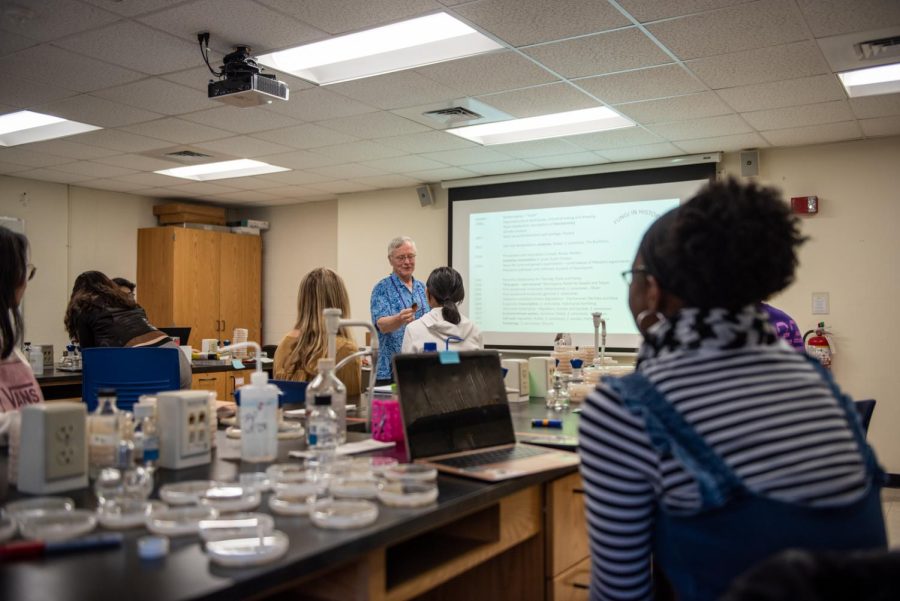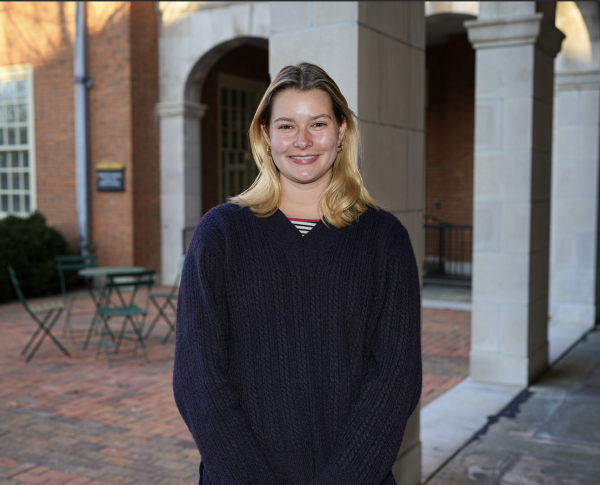Mycology & Magnolias: A world of fungi
An undergraduate mycology lab studies the fungi living in Wake Forest’s magnolia trees
Dr. Brian Tague instructs students on mycology.
February 9, 2023
The magnolia tree, Wake Forest’s staple, offers a home to diverse fungi. A research lab in the biology department, however, discovered that some of these fungi are potentially pathogenic.
Dr. Brian Tague, a biology professor at Wake Forest who specializes in plant and cell biology, has integrated the study of fungi into every one of his classrooms. In his four-credit hour biology class, Mycology: Biology of Fungi, BIO 327, Tague aids students in exploring the taxonomy and evolution of fungi, as well as their interactions with other organisms.
Mycology is the study of fungi, the natural decomposers of our world. Fungi act as decomposers by recycling nutrients from dead organisms back into the environment, and they provide plants with phosphorus, carbon and nitrogen. These elements are used in DNA replication for the plant, as well as in building and stabilizing its cell wall — the plant’s support and defense system.
Some fungi, such as mycorrhizal fungi, communicate through underground pathways and signals, sending these nutrients to trees of different species. Others, such as endophytic fungi, are found in the leaves of trees. These fungi can either be beneficial or parasitic to the plant.
The lab portion of Tague’s mycology course focuses on the latter type — the fungi living on the magnolia trees’ leaves.
In the lab, students collect leaves from magnolias and identify the different endophytic fungi present. The lab has found that the one recurring fungus is Diaporthe. This fungus is commonly found in magnolia leaves and acts as a pathogen, a disease-causing bacteria or virus.
In the experiment, students collect leaves from the magnolia trees behind Winston Hall, making sure the leaves are from the same branch, size and age. Once collected, a 0.5 cm leaf disk is made with a hole puncher and treated with bleach and ethanol. After this, the sterilized disk is placed on a petri dish that has the appropriate fungal media, such as agar, dextrose and potato starch. After a few days or weeks, students watch the fungi grow from the disk onto the petri dish plate. Once grown, the fungi can then be identified.
So far, students have identified many different types of fungi on identical neighboring leaves. Some of these include Colletotrichum, Alternaria, Xylaria and Cladosporium.
“It seems to me that every leaf is a new, random assembly of a community, and in ecology, it’s hard to replicate things,” Tague said. “I can find 25 different species in one leaf…the problem is disentangling who’s doing what in there.”
For example, Colletotrichum is a fungus that lives in symbiosis with plant leaves and could act as an endophyte or a pathogen.
So, how did the fungi get here?
“My hypothesis would be, because I always find this [fungi] in a leaf,” Tague said. “Maybe this [Diaporthe fungi] has multiple ways of getting around, through spores or the fungi have other tricks as it can move through the vascular system of the plant.”
Both Tague and his mycology class will continue to analyze these fungi samples to see what kinds of fungi live on the magnolia leaves. They will also continue to hypothesize how the fungi appeared, and why some leaves have different kinds/amounts of the fungi than others.
Una Wilson, a junior biology major, took Tague’s lab sophomore year and is now taking her studies abroad. Wilson initially discovered her passion for studying fungi through a podcast named “From Tree to Shining Tree,” which discusses how fungi are the known chemical liaison of our world, sending chemical signals and nutrients through their underground networks.
“One big reason I was interested in being in the lab is how fungi represent interconnectivity,” Wilson explained. “If we examine this concept, it stretches beyond the field of science. We can see common threads and commonalities between people.”
Wilson took her biology studies internationally this past summer. In Puerto Maldonado, Peru, Wilson extracted soil samples from gold-mined areas to see if there were mycorrhizal fungi present. Mycorrhizal fungi reside on the roots of a plant below the topsoil and enhance the nutrient uptake of a plant. Her soil samples are still being held at Customs, but once they are back in her hands, she will be able to draw a conclusion from her hypothesis. If there are mycorrhizae present, this would be a key indicator that these areas have hope of being reforested and nutrients restored to the plants, according to Wilson.
“Trees rely on one another more than we can see,” Wilson said. “Beneath the forest floor, fungi are associated with tree roots, and they do this between trees of different species. Every tree in a forest can be connected by one single fungus.”
Mycorrhizae’s complex networks can be difficult to comprehend, but they can be seen as similar to a neurological pathway.
“Think of it like a brain — we send neurons like the trees send chemical signals,” Wilson said. “There are hundreds of miles of trees all interconnected with one another. Carbon, nitrogen, phosphorus and lignin can be sent to each other through the fungal network.”
Mycorrhizae fungi’s extent of communication is still in the research phase as a working hypothesis. Tague sees trees “communicating” being a stretch, and that they share resources, not information as the term to which communication may allude to.
However, Tague and his students are all learning together, and every week they set out to collect more data to draw hypotheses.
“I picked to study fungi because they are interesting,” Tague said. “They come in a variety of shapes, colors, smells and sizes…animals are more closely related to fungi than plants.”
Fungi and animals are both heterotrophs, meaning they obtain their nutrients from a source. While animals get nutrients from eating, fungi receive subsistence from absorbing nutrients through their mycelial networks and subsequently by decomposing organisms.
We, as humans, are more closely related to fungi than fungi are to plants. Students in Tague’s lab will continue to work on gathering data and forming hypotheses on our close relatives.
In the future, Tague said he might integrate the mushroom “coincap” into his lab. The magnolia coincap, scientific genus Strobilus, lives on the magnolia conifers. Integrating the coincap would open new doors of exploration for him and his students since they have never focused on the cones before, just the leaves.
Although he is unsure of whether these fungi will be a successful experiment, Tague says he wants his experiments to be “fun, successful and interesting” activities that will continue to educate Wake Forest undergraduates.















